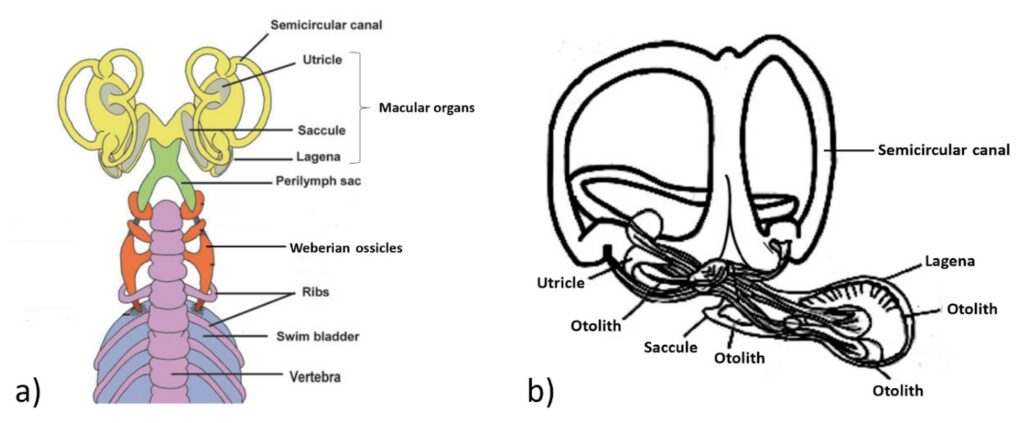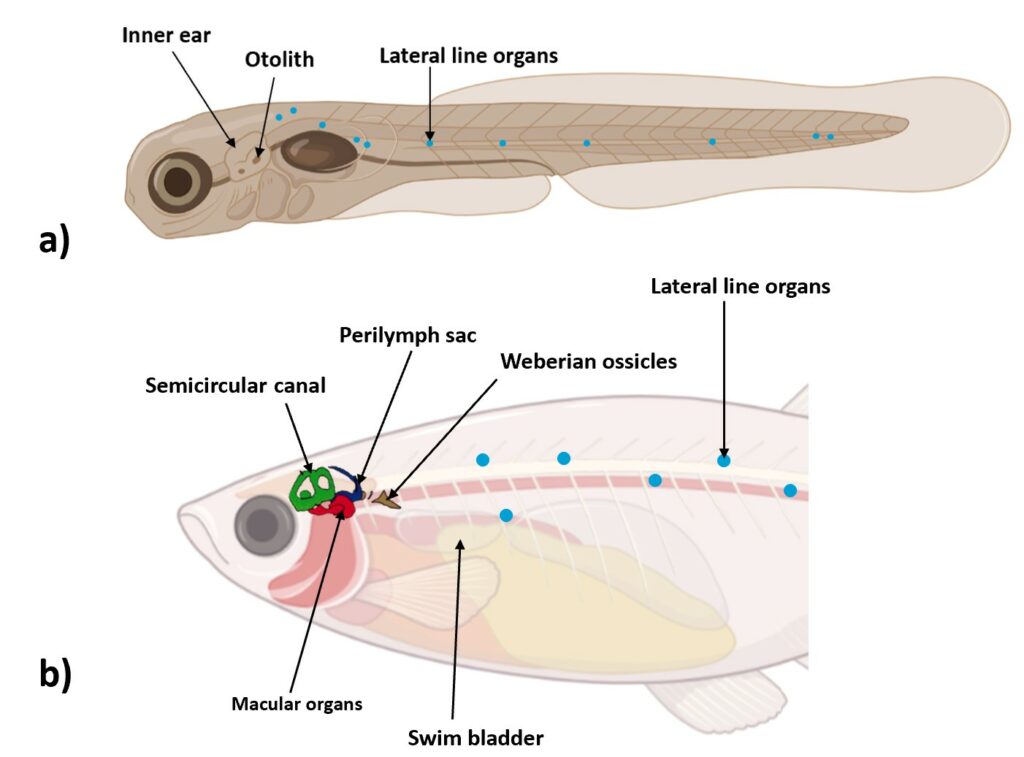In laboratories and fish facilities, environmental noise management is essential to ensure the well-being of zebrafish and optimize their reproduction. Noises from the aquarium facility, as well as from human activities, can influence zebrafish behavior. In this article, we talk about how fish react to environmental sounds and how music, especially classical music can positively influence fish behavior and make experiments more reliable.
Zebrafish hearing
Zebrafish can detect sounds, vibrations and motion through their well-developed auditory system. Their auditory system is composed of the vestibular labyrinths, which include the macular organs and three semicircular canals. The vestibular labyrinths are highly conserved in structures and functions in vertebrates [1].
The macular organs are in the number of three and are named saccule, utricle and lagena. They are a coupling between receptors, called hair cells, and otoliths. In addition to their role in hearing, they are important in sensing linear acceleration and gravity. Hair cells send signals to the brain through the 8th cranial nerve. Otoliths are structures composed of calcium carbonate crystals [1] .

In zebrafish, deafness is one of the most common inherited diseases. It’s due to very high hair cell sensitivity [1] .
Zebrafish are classified as hearing specialists because of the presence of bones called Weberian ossicles. These bones connect the swim bladder to the saccule (one of the macular organs). The role of Weberian ossicles is to transmit the movement of the swim bladder to the hair cells [1]. In fact, the swim bladder is a kind of bag full of air which is important for buoyancy [2] and it can be slightly moved by sound. It also allows fishes to detect pressure [3].
In addition to these auditory systems, fishes (and also frogs) have lateral line organs, which can detect low-frequency stimuli like water movement. This is an important advantage in particular for prey detection. Lateral line organs are a series of cell clusters localized along the trunk [1], [4].

Anthropogenic sound effects on zebrafish
Anthropogenic sounds are human generated sounds. This includes voices, mechanical noises and also sounds generated by human installations in the tank like tank pumps, and filtration and aeration systems [3].
These unnatural sounds can affect zebrafish swimming behavior, their swimming speed and their position in the water column. Freezing behavior has also been observed and it is characteristic of anxiety-related behaviors in zebrafish [3].
If sounds are too loud, hair cell damage has been observed and in some cases also hearing loss [3], [5].
In larvae development, negative sound effects have been observed as a disturbance of body symmetry and tail morphogenesis [5].
A peculiar aspect is that zebrafish and non-mammalian vertebrates can regenerate their hair cells [5], [6]. In fact, a pool of stem cells are capable of producing new hair cells after trauma. Zebrafish auditory threshold recovers in 7-14 days depending on the amplitude of the exposed noise [5]. This is an important aspect in research to identify common hair cell regeneration mechanisms between zebrafish and other species, which may in the future be used to induce regeneration in mammalian inner ears [6]. This is a significant prospect for medical treatment of deafness in humans.
Classical music effects on zebrafish
As seen, anthropogenic sound has negative effects in zebrafish development and behavior. On the other hand, some experiments have demonstrated that classical music can positively modulate zebrafish anxiety-like behavior [5], [7], [8].
Experiments about the classical music effect on zebrafish have been done mainly with Vivaldi’s music. Zebrafish exposed to Vivaldi’s music appear calmer [7], [8], spend significantly less time at the tank bottom, travel longer distances and spend more time moving [8]. Besides, there is also an effect on reproduction as classical music enhances the metabolism [8],[12] and modulates zebrafish physiological states [8]. Another effect observed is that Vivaldi’s music reduces some negative impacts of acute social isolation [7].
The fact that classical music reduces anxiety and reduces the impact of social isolation may help to make experiments with high reproducibility and with valuable data. As already mentioned, anthropogenic noises are not well tolerated and can deteriorate the value of a study. Moreover, for a laboratory, classical music could then represent a great way to apply the 3Rs principle and particularly the laboratory animals’ life refinement [7].
Music can be considered as an auditory environmental enrichment. Environmental enrichment is important to reduce anxiety but also to ensure proper brain development because it acts on brain plasticity and induces an increase in neuron density [5], [9]. Environment enrichment is defined as : “a combination of complex inanimate and social stimuli that provide laboratory animals with a better choice of activity and a greater control over social and spatial stressors” [10].
All these effects have also been observed in other laboratory animals like dogs, primate and rodents [7]. Music exposure can also affect the microbial life cycle [12].
And what about humans ? Music therapy is used as an alternative to treat depression and anxiety [11]. Studies have been done to see physiological responses to music in cases of gastric carcinoma cell lines, and breast cancer cell lines. The results of these studies show that classical music reduces the activity and viability of the cancer cells [12]. In relation to the behavior, classical music increases wellbeing and cognitive performance and reduces stress and anxiety [8].
Conclusion
Anthropogenic sounds can affect zebrafish physiologically and can also modulate their behavior. This may represent a bias in laboratory experiments with zebrafish. But music and especially classical music like that of Vivaldi can counteract the negative effects of unnatural noises.
Classical music has an important anxiolytic effect which is beneficial for the reproducibility of the experiments and for the reliability of the results obtained. Music may also be an interesting aspect to develop as part of the refinement of the 3Rs method.
But some aspects are still unclear. In fact, in all these studies, music and sound are played outside of the tank and it is still uncertain how zebrafish perceive it. In addition, sound ranges are arbitrarily chosen according to a pleasant level for the human ear. It should also be remembered that sounds perceived in the air are not equal to those perceived in the water. Actually, sounds are attenuated when crossing the air-water interface. The appropriate sound level for the zebrafish still needs to be clarified to ensure that the effects of the classical music are optimal [3], [8].
References
- Nicolson T. The Genetics of Hearing and Balance in Zebrafish. Annu Rev Genet. Feb 2005;39:9‑22.
- Menke AL, Spitsbergen JM, Wolterbeek APM, Woutersen RA. Normal anatomy and histology of the adult zebrafish. Toxicol Pathol. Aug 2011;39(5):759‑75.
- Popper AN, Sisneros JA. The Sound World of Zebrafish: A Critical Review of Hearing Assessment. Zebrafish. Apr 2022;19(2):37‑48.
- Stengel D, Zindler F and Braunbeck T. An optimized method to assess ototoxic effects in the lateral line of zebrafish (Danio rerio) embryos. Comparative Biochemistry and Physiology, Part C. 2017; 10.1016
- Wang J, Wang D, Hu G, Yang L, Liu Z, Yan D, and al. The role of auditory and vibration stimuli in zebrafish neurobehavioral models. Behav Processes. Dec 2021;193:104505.
- Lush ME, Piotrowski T. Sensory hair cell regeneration in the zebrafish lateral line. Dev Dyn. 2014;243(10):1187‑202.
- Marchetto L, Barcellos LJG, Koakoski G, Soares SM, Pompermaier A, Maffi VC, and al. Auditory environmental enrichment prevents anxiety-like behavior, but not cortisol responses, evoked by 24-h social isolation in zebrafish. Behav Brain Res. Apr 2021;404:113169.
- Barcellos HHA, Koakoski G, Chaulet F, Kirsten KS, Kreutz LC, Kalueff AV, and al. The effects of auditory enrichment on zebrafish behavior and physiology. PeerJ. July 2018;6:e5162.
- Pittman JT, Lott CS. Startle response memory and hippocampal changes in adult zebrafish pharmacologically-induced to exhibit anxiety/depression-like behaviors. Physiol Behav. Jan 2014;123:174‑9.
- Volgin AD, Yakovlev OV, Demin KA, Abreu MS de, Rosemberg DB, Meshalkina DA, and al. Understanding the Role of Environmental Enrichment in Zebrafish Neurobehavioral Models. Zebrafish. Oct 2018;15(5):425‑32.
- Erkkilä J, Punkanen M, Fachner J, Ala-Ruona E, Pöntiö I, Tervaniemi M, and al. Individual music therapy for depression: randomised controlled trial. Br J Psychiatry. Aug 2011;199(2):132‑9.
- Rajendiran S and al., Research Models and Practices Practices Pertaining to Carnatic Music Therapy , Indian Journal of Research in Pharmacy and Biotechnology, vol.10, n°2, Apr 2022, doi:10.31426/ijrpb




